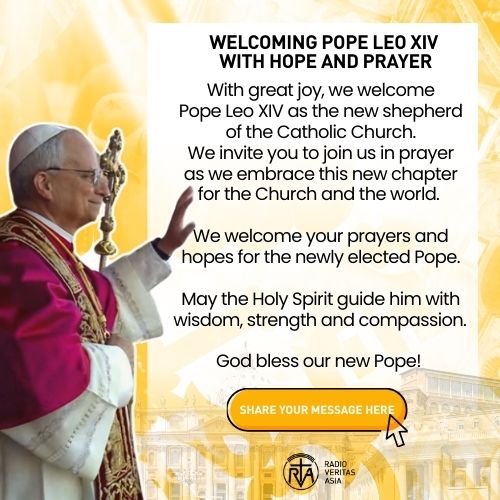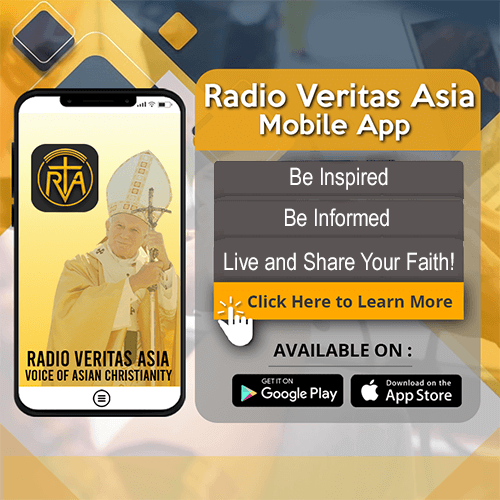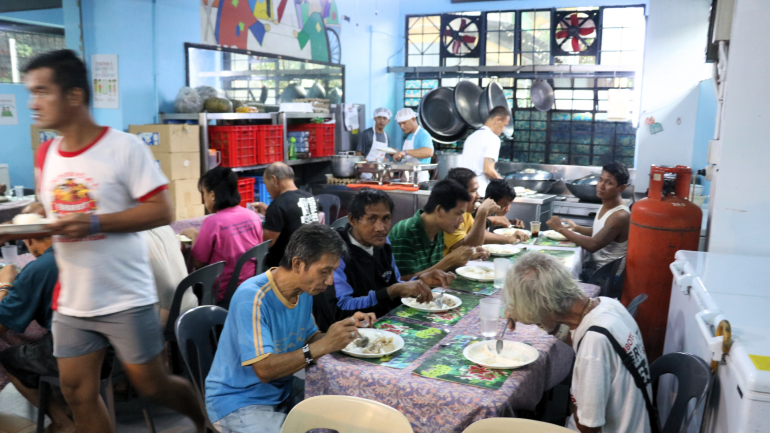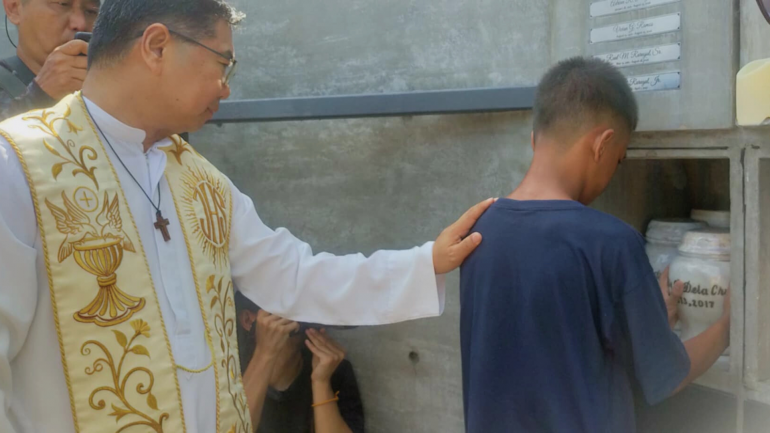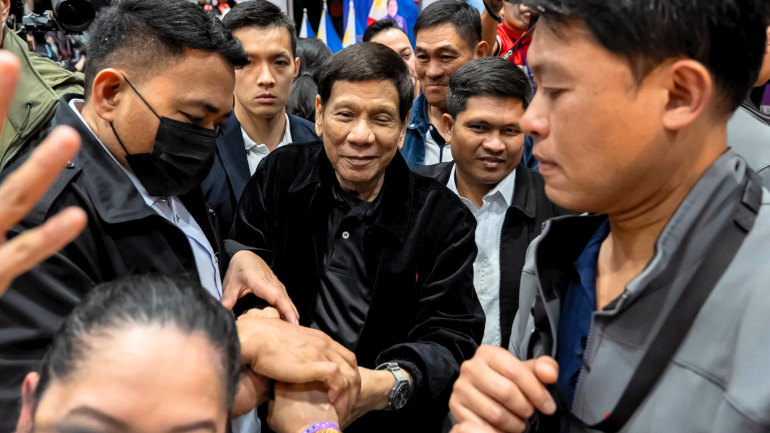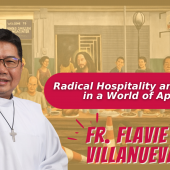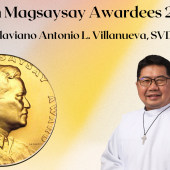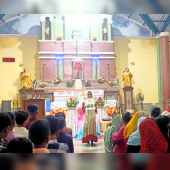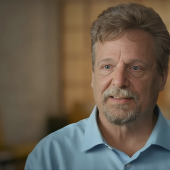“If you need help, please call me”
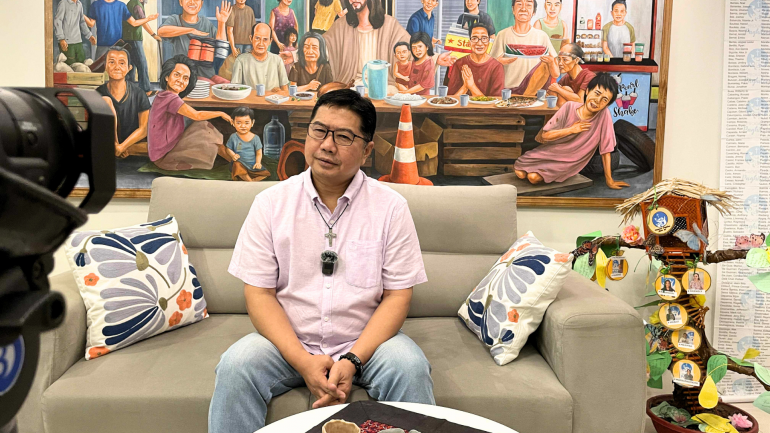
An interview with Fr. Flavie Villanueva, SVD – Founder of Arnold Janssen Kalinga Center and Program Paghilom, Manila
“My name is Flavie Villanueva. Or Flaviano, when my mother is mad at me” - is how the 55-year-old Divine Word missionary introduced himself to the RVA team when we caught up with him for a conversation in his office at the SVD Provincial House in downtown Manila.
Outside, it rained. On our way there, just around the corner of Tayuman Street and Oroquieta Road, we saw a group of homeless people standing in a clearly planned formation, persons with disabilities in front, followed by the elderly and children at the end. They were waiting outside the Arnold Janssen Kalinga Center for their turn to receive the Center’s ‘radical hospitality’.
It was a busy weekday. In the small, modestly furnished parlor where we were welcomed, every corner you turned to offered a monument, whether a drawing, a sculpture, or even a scroll of names, that told the story of Fr. Flavie’s mission. To his right, he wore a wooden 10-beaded rosary from Vietnam and a black band that read, “Stop Killing, Start Healing.” “I’ve been wearing this band for the past ten years,” he said. As he sat on the couch, above him hung a large painting of the Last Supper, with a difference: in place of the apostles were homeless men and women of Manila.
From the look of Fr. Flavie, jeans, rubber sandals, a light pink priest’s shirt, and a metal cross hanging from a black cord around his neck—he could easily be mistaken for a “regular” Catholic priest. But he is not. He is the founder of the Kalinga Center, where, four times a week, around 350 homeless people in Manila receive unprecedented hospitality: a warm welcome, access to showers, counseling, and as much food as they can eat. Fr. Flavie was also a vocal and fearless opponent of former President Rodrigo Duterte’s infamous ‘War on Drugs’. His initiated Program Paghilom (“healing”), a psycho-spiritual and holistic program that provides care and support for the bereaved families of victims of extrajudicial killings. His political activism was met with charges of sedition from the government.
RVA’s Social Media Coordinator, Cindy Gorospe, who conducted the interview, began lightheartedly, “Father, are you ready to defend your thesis?”
The Filipino priest replied with a grin, “I usually begin my defense by asking if the panel is ready.”
In a conversation that lasted well over an hour, Fr. Flavie spoke on a range of topics, from his time in the corporate world to his priestly vocation, from the founding of the Kalinga Center to his political activism, from his journey of faith to his dreams for the center’s future.
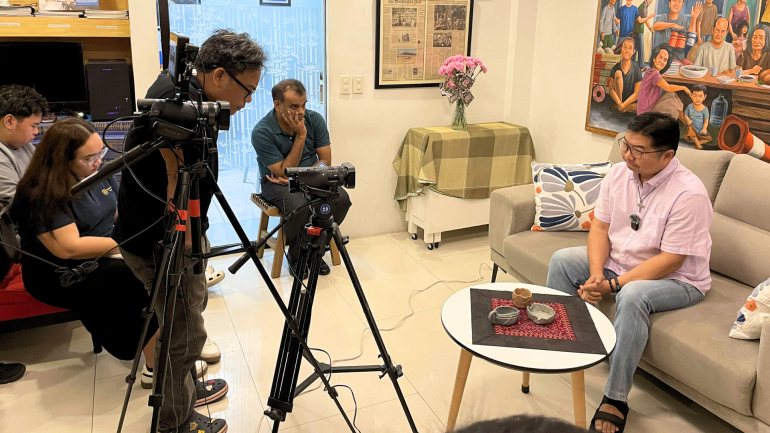
What personal experiences or moments led you to found the Arnold Janssen Kalinga Center?
To be honest, the Arnold Janssen Kalinga Center began as just a dream. I never planned it. Ten years ago, I wouldn't have imagined it.
But reading the signs of the times, especially when I was appointed Justice and Peace Coordinator for the Society of the Divine Word in the Central Province, has opened my eyes to the plight of the homeless. More importantly, when I met them, saw them, and lived among them for hours and days, I realized they needed more than food.
They needed extraordinary care, one that suspends judgment and lets them feel the love of God. I also saw that hygiene was a major need. Beyond food, access to clean toilets and showers was something they deeply longed for.
In 2014, Kalinga Center began to take shape.
Over the past ten years, what would you say were some of the Center's biggest achievements and greatest struggles?
I’m not sure whether to begin with the struggles or the achievements, because I do not compartmentalize the two. The challenges were there right from the start. The idea itself wasn’t easily embraced, even by my own community. The proposal was rejected, often on grounds of money or because “it’s never been done before.” Understandably, superiors have to be practical in their decisions.
But I believe the hand of God was in this mission from the very beginning - precisely because nothing like it had been done before. No one offered showers to the homeless before. No one embraced them and said, “I’m doing this because it’s a commandment.”
We welcomed the homeless, without any bias.
We even created a format for that welcome: we start with the crippled, the lame, persons with disabilities, the elderly, and the children come last. Some question this, but we do it intentionally. It is a teaching moment. We don’t want to romanticize the children; we want to teach them how to care for others. We love them, and that’s why we teach them kindness, compassion, and respect for elders.
One of the hardest struggles was gaining acceptance, both for the ministry and the homeless community we were serving. I remember being shut down by barangay officials and the police. During the pandemic, we were treated worse than stray dogs, told to go home. One policeman shouted, “Go back to your homes!” I wanted to say, “Are you crazy? Don’t you see? That’s why they’re called homeless; they have no homes to go back to.” And then there was silence.
The painful truth is that many of these same people go to church, make the sign of the cross, and say “God bless you.” But when it comes to society’s rejects, the homeless, the street children, they want nothing to do with them.
Despite all that, we’ve seen so many beautiful stories. Moments that stay with you. Like when someone says “thank you” after a meal. Or comes back for a second, third, even fourth serving, still with a clean plate and deep gratitude. Or when someone smiles after a bath, freshly groomed, and ready to face the day.
These are daily signs of God’s presence, God combing their hair, touching their hearts, saying, “You are my beloved.” When a homeless person experiences that kind of love, that, for me, is beyond achievement. It’s a story worth telling.
Many consider Kalinga a place of radical hospitality. Could you explain what that means?
I love the person who coined that. It’s like Jesus, radical in his time. Maybe that’s why I have a sedition case myself, for trying to be radical like him.
For me, radical hospitality means offering the kind of compassion the world no longer sees. It’s caring for those often ignored, not because they can give something back, but simply because that’s what the Gospel asks of us.
It’s hospitality that goes beyond convention, not for attention or praise, but to love as Jesus loved. As he says in Matthew 25: “When I was hungry, you gave me food.” That’s what we try to imitate, and what we hope the world will follow.
How do you see the ministry of Kalinga five or ten years from now? Are there any future plans for expanding the ministry?
I would like to share the dream of my dear Cardinal Chito (Cardinal Tagle), the one who blessed the center, a very good friend and shepherd. He said that after ten years, the Kalinga Center should close down. Meaning, there would no longer be a need for a center that caters to the homeless, because there would be no more homeless people, at least in Metro Manila.
But that is an ideal.
So, let me dream of the opposite. Let me pray and work for the opposite, which is greater recognition and care for the homeless. The first thing we must recognize is that they are human beings. Bato ba sila o ilaw lang? Hindi! (They’re not rocks!) They have hearts; they carry within them the image of God.
I like to appeal to everyone: when you see someone different, especially someone on the streets, look at them through the eyes of God, as one created by God.
The second thing, let us care for them the way Jesus would care for them. Many might say, “But we don’t have the funds, we don’t have the resources.” Look at the story of Kalinga. I was alone when I started. I didn’t have money, just ₱7,500. We just have to pray and believe in the mission, the mission of God.
Now, moving on to your other important advocacy, could you tell us what prompted you to begin Program Paghilom?
That’s a question I rarely heard when Duterte was president. It’s only now, under BBM (Bongbong Marcos), that people are more open to asking about Program Paghilom. But I thank God it’s now gaining attention and being sustained, thanks to people like you who help promote it.
To be honest, it wasn’t hard to discern the need for the program. I’ll admit it openly, I voted for Duterte. I voted for a man I now call a butcher, a mass murderer. And I deeply regret it. I believe the Church bears some responsibility for what has happened. We failed to speak out clearly. From 2016 to 2022, how much noise did the Church really make? I remember one congressman saying, “I miss the Church, the one that marched in the streets to protest the Reproductive Health Bill.” We defended the sanctity of life at conception- that tiny, little cell. But what happened when that cell grew into a full-grown man, able to love and live, and was then slaughtered by the hundreds, often unjustly? Where were we?
Many stayed silent. And if Duterte succeeded in anything, it was in his campaign of fear. It was all-encompassing. But not everyone was silenced. Some shepherds stood up, and their courage inspired me.
Coming from the experience of the Kalinga Center, I saw the need for a dignified, systematic, and holistic program, not for the homeless this time, but for the widows and orphans left behind by the drug war. Most of those killed were breadwinners. (Pointing to a scroll of names hanging on the wall) I showed this list, 327 names, to Congress and the Senate. All of them were providing for their families. When you take away the breadwinner, the family ends up on the street. Program Paghilom was born from that reality, one that aligned with what we were already doing at Kalinga.
You mentioned that there were some shepherds who refused to be silence by the fear campaign of Duterte. Could you elaborate on that a bit?
Yes, there were shepherds who stood up to Duterte. You could name, for instance, Fr. Amado Picardal, the Redemptorist, who was the first to bring out the documents about Duterte’s killing spree in Davao, along with Fr. Albert Alejo, SJ. Then there’s Fr. Robert Reyes, who also spoke out, and now-Cardinal Ambo David, who was then the bishop in Caloocan, ground zero of the carnage. Bishop Broderick Pabillo, Archbishop Soc Villegas showed deep compassion and courage.
There were also other priests who protested and denounced the killings. The CBCP, led by Cardinal Chito Tagle at the time, did issue statements. But over the six years of Duterte’s rule, we need to ask: how many official Church pronouncements were made? And how do they compare to the near-daily tirades of Rodrigo Duterte?
I think we were greatly outnumbered. Evil triumphed during those years, one of the darkest periods in our history, second perhaps only to Marcos Sr’s dictatorship.
Let’s go back to Program Paghilom. We understand that it is made up of seven stages. Could you walk us through those stages of healing?
Just like at the Kalinga Center, we also follow a system of care here. The healing process begins with vetting. In the early days, I didn’t know where to find the families, so I joined underground meetings where one or two victims would be discreetly introduced. I remember once handing someone a handkerchief and a note that read, “If you need help, please call me.” Two weeks later, she did.
I would vet not just their stories, but their needs. The top three were always the same: financial help for funerals, which could cost anywhere from ₱35,000 to ₱75,000, daily sustenance, and handling deep trauma. Imagine a family that earns ₱200 a day being charged ₱70,000 to bury their loved one. That’s exploitation. And often, the funeral homes were in collusion with police.
After vetting, we begin with psycho-spiritual intervention, the heart of Paghilom. We designed a 7 to 12-week Saturday program to help survivors process their grief and trauma. At first, I facilitated it myself, but as more families joined, I sought help from psychologists and counselors. Healing is carried out through courageous, compassionate, and competent care.
So far, we’ve had 21 batches, supporting 327 families, and counting.
The next stage is legal assistance. This is sacred work. Families create affidavits telling the true story of how their loved ones were killed, stories that often contradict the police reports. Police reports usually mention the type of gun, the supposed drugs found, and claim that the victim fought back. Sometimes, very rarely, it mentions the number of gunshots sustained.
Next, we provide educational and livelihood support, followed by leadership formation. As the number of beneficiaries grew to 80 or more, we began training leaders from within the community to help sustain the program.
The seventh stage, which began during the pandemic in 2022, is Project Arise. We go into cemeteries to exhume remains from apartment graves before they’re discarded. With the help of our dear friend Dr. Raquel Fortun, we perform autopsies, cremate the bodies, and return the urns to families so they can properly mourn. These urns are then laid to rest in a columbarium we established, the first of its kind, called The BARN: Bantayog ng mga Pinatay sa Giyera Kontra Droga, a proper resting place for the victims, where families can visit and find healing.
Can you tell us about the handing over of the urns to the families? How does it attend to the emotional and spiritual needs of the grieving family?
The handing over of the urns is one of the most sacred moments in the entire process. During the ceremony, I often notice something deeply moving, many family members don’t wait for the urn to be fully handed over. They reach out, grab it tightly, and hold it close, caressing it.
It took me a while to understand this reaction. Then I realized, it’s the longing for an embrace that never happened. During the wake, there was no time to grieve properly. The killers were still out there. The police would often say, “You can’t have a long wake.” They did not want any sympathy to be created for the victim. The families were silenced, rushed, and threatened.
They weren’t even allowed near the crime scene, allegedly for investigation, but we later found out that it was the time evidence was planted: the gun, the drugs, the narrative.
The families were robbed not just of justice, but of closure, of love, of the final goodbye.
So when we hand over the urns, it’s more than ashes. It’s an invitation to finally grieve - to hold their loved one last time with peace, dignity, and love.
You called out Duterte on his so-called 'War on Drugs', describing it instead as an attack on public health. Could you elaborate on that?
The reason I stand with the EJK (extra-judicial killing) families is that their loved ones were branded as drug addicts. In my own short experience with drugs for fifteen years, fifteen years is a short time, huh? he chuckles, I sought help through spiritual direction and counseling. I found healing and redemption, which convinced me that people struggling with addiction need care, not condemnation. They need counseling, mental health support, not someone putting a bullet through their head and blasting their brains off.
Rodrigo Duterte created a powerful narrative: that he hated drugs and would wage war against them. No one in their right mind would support substance abuse, of course. But his so-called “war” wasn’t really against drugs, it was a war on the poor. The victims weren’t the rich or powerful. They were the voiceless, the vulnerable.
Go to Davao now, it’s a hub of drug laboratories. Sources tell me the drugs were never cheaper than during Duterte’s time.
So when he said he hated drugs, he lied. His so-called “war” was a great deception. It was one of the most evil things a leader could do: to hide behind a narrative and justify a killing spree - and use it to legitimize his hold on power.
The war on drugs has polarized the Philippines for several years. One of the narratives pushed in the propaganda is that if you are against the war on drugs, then you must be a drug addict yourself or you support addiction. As someone who once struggled with addiction and found redemption through spiritual counseling, how do you view such claims?
My story has been an open book even before my ordination in 2006. But it was something I was never proud of. I never talked about it publicly. However, I knew I had to speak up when Duterte launched this dubious and evil campaign, saying drug addicts should be killed, should be eliminated, or, to use their technical term, "neutralized”.
That, for me, was very frightening. You’re giving someone the authority to end life, when life, even if broken, even if wounded, can still be mended. Life can still be fixed. This campaign only added to the culture of violence and death. It gave permission, no, it gave power, to barangay officials and police to decide who lives and who dies.
Duterte created this evil culture. And if I may say so, having studied him, the mind of Duterte is cultic in nature. The person of Duterte, by all accounts, could very well be the epitome of evil. He is someone who curses God, ridicules the Church, and wishes ill and death on others. That is not normal. That, for me, is evil by its very nature
When Duterte was arrested last March, you publicly said, “Salamat sa Diyos, mga tao.” What were your thoughts and emotions in that moment?
It was a feeling of redemption. It was a feeling of great joy, to the point that, though it was Lent, it gave me the license to sing Hallelujah. It was a marvelous feeling of Easter.
And that goes as well with the widows and the family members of the victims. One of them said to me, ‘Totoo nga, Father. Totoo, hindi Siya natutulog.Naririnig Niya tayo’ ( ‘Truly, there is a God. Truly, He never sleeps. He hears the cry of the poor.’)
What message do you have for the families of drug war victims who are still waiting for justice?
My message to the families victimized by Duterte’s war on drugs is simple: Hold on. Hold on to your truth. Hold on to one another.
As we often say now in Program Paghilom, 'Isa ang nawala sa akin, pero isang buong pamilya ang natagpuan ko. ("I may have lost one loved one, but I have found a whole new family")
The capture of Duterte is not the end. We will continue to run after the other culprits. A house is built by many hands; there’s the architect, yes, but also the carpenter, the mason, the painter, the electrician. All of them made that bloody house called the war on drugs. And we are close to naming and apprehending them all.
In this long journey and quest for justice, know that the crucified and risen Christ is with us. Kasama natin Siya (God is with us).
Radio Veritas Asia (RVA), a media platform of the Catholic Church, aims to share Christ. RVA started in 1969 as a continental Catholic radio station to serve Asian countries in their respective local language, thus earning the tag “the Voice of Asian Christianity.” Responding to the emerging context, RVA embraced media platforms to connect with the global Asian audience via its 21 language websites and various social media platforms.


